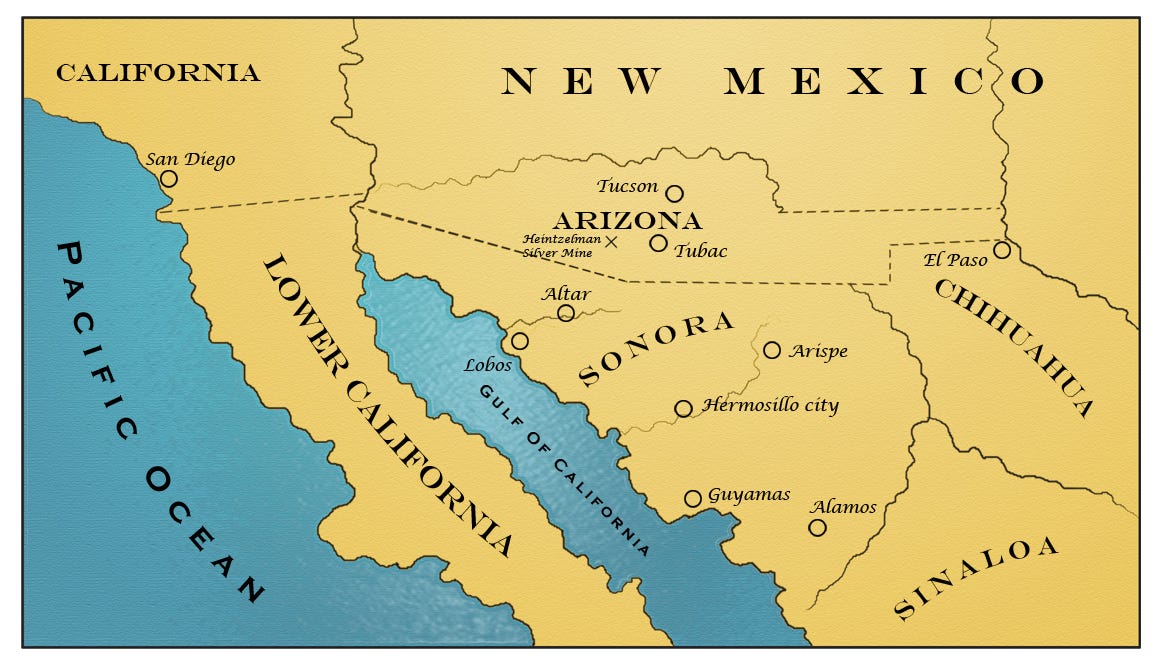Typical disclaimer here – I am writing from an American point of view. I am trying to be honest, but some incorrect assumptions may still seep through.
Gadsden Strip Purchase
In elementary school in Southern California, this is what we were taught about the Gadsden Purchase (paraphrasing):
The United States easily won the Mexican American war. The country expanded to the Pacific, taking the rich state of California with it. In 1853, to promote good relations with Mexico, the USA purchased the Gadsden Strip. This was an unimportant area that the United States overpaid to make up for the annexation of the rest of the territory Mexico lost in the war.
That is not what actually happened.
Before 1840 Mexico controlled the current states of California, Nevada, Arizona, Utah, New Mexico, Texas, and parts of Oklahoma, Colorado, and Wyoming. Mexico’s control over the area was limited by the distant soldiers had to travel and the antagonism of new settlers to the government far away. This northern area of Mexico was still battling Comanche and Apache warriors, stretching the resources of both Mexico and the United States. The native warriors would attack quickly and then disappear back into the hills and arroyos.
Texas and the Rio Grande Valley were populated by American’s, often bringing their slaves with them. In Mexico slavery was illegal and Texan settlers were breaking the law. In 1845 Texas joined the United States, following a war of independence from Mexico. Texas was an independent Republic for 9 years before financial problems lead to Texas to end the Republic.
The Mexican American war followed the Texas cession quickly. Texas was annexed by the United States, at the urging of Texans who proclaimed independence, in 1845. The Mexican American War started soon after in 1846. The war resulted in Mexico losing a lot of territory to the United States. But those loses did not include the lower elevations around what is now Tucson.
And this land was desired by the Southern Pacific Railroad for a transcontinental railroad to southern California. The southern (slave) states desired to extend southern slave states to the Pacific. The US delegation attempted to purchase The Gadsden Strip, Baja California, and Sonora. The price paid was $10 million after negotiations and mutual promises of taming native incursions – which never really happened.
The treaty was passed in Congress by the necessary 2/3 vote, but the slave state / free state acrimony in the negotiations left the railroad in limbo until after the Transcontinental railroad was completed on the northern route.
Baja California / Lower California
After the negotiations over the Gadsden Strip were completed, Baja California (Lower California) was kept as part of Mexico. That did not stop a business group from San Diego trying to establish a state of Lower California. Using Texas as a template for cession to the United States, these businessmen purchased extensive land holdings to pry the area from Mexico.
The United States and Mexico had begun negotiations for the purchase of Baja California and were extremely close to finalizing them in 1917 when World War I broke out in Europe. This sidetracked the negotiations, and they did not pick up after the war.
The actions of the Americans in Texas, then Baja California incited Mexicans enough to force the federal government to forbid foreign ownership of land in Mexico. Later that was amended to property within 31 miles of the Ocean or 62 miles from the international border.
Americans can now buy property in these areas by creating a Mexican entity and it relatively easily done with lawyers. But the original restrictions are in the Mexican Constitution and not easily amended.
Although not “colonized”, Baja California and in particular the areas around Cabo San Lucas and La Paz are now well developed and host to hundreds of thousands of Americans and their second homes. English is widely spoken and US dollars can be used as easily as Mexican Pesos there.




